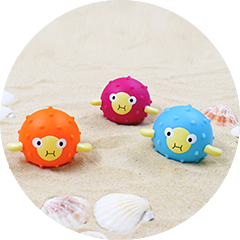Introduction
Swimming is a life skill, and the earlier it is introduced to a child, the better. While the initial foray into the water can be daunting for some babies, there is a secret weapon parents and instructors can use to make this transition smoother and more enjoyable – toys. This article delves into the significant role toys play in baby swimming, transforming the experience from potentially intimidating to highly engaging and educational.
The Importance of Toys in Baby Swimming
Toys are not just fun distractions; they serve as critical tools in the swimming learning process. They make the unfamiliar environment of a swimming pool more inviting and less intimidating. By providing a point of interest, toys can distract a baby from any initial discomfort or fear they might feel, allowing them to relax and enjoy the experience. Moreover, toys can also assist in developing essential swimming skills such as kicking, floating, and breath control, paving the way for confident, independent swimmers.
Types of Swimming Toys and Their Benefits
There is a wide array of toys available, each offering unique benefits:
Floating toys: These toys can motivate babies to move in water. Chasing after a floating toy can encourage a baby to kick and paddle, stimulating motor skills development and enhancing coordination.
Sinking toys: Once a child is more comfortable in the water, sinking toys can be introduced. These can help improve underwater skills and breath control as the child dives to retrieve them.

Image source: Splash About
Musical toys: Such toys can be used to add a rhythm to the swimming experience. They can help teach babies about rhythm and timing, which are important in coordinating swimming strokes.
Safety Considerations When Choosing Swimming Toys
While toys can enhance the swimming experience, safety should always be the primary consideration. Always opt for toys specifically designed for water play. These toys are typically made from non-toxic materials and are designed to resist water damage. Moreover, ensure the toys are the right size to prevent choking hazards and small enough to be easily grasped by tiny hands.
Integrating Toys into Swimming Lessons
To effectively use toys in swimming lessons, they should be integrated into the learning process. For instance, a floating toy can be used to teach a child to kick towards a goal. Alternatively, a sinking toy can be used to encourage diving and breath-holding.
- Puffy Pals Bath Toy
- Squiggle Wiggle Dive Fish
- Splash Balls
- Pufferfish Flip & Float Toys
- Pack of 3 Pufferfish Pool & Bath Toys
- Floaty Fun Squid Dive Toys
- Splash Dive Streamers
- Neoprene Pufferfish Splash Balls Purple
Frequently Asked Questions About Baby Swimming Toys
What age should my baby start using toys in the swimming pool?
While it can vary, once your baby is comfortable in the water (usually around 6 months), you can start introducing toys. However, always ensure the toys are age-appropriate and safe for your baby.
Are there any specific brands of swimming toys that you recommend?
There are numerous reliable brands that manufacture baby swimming toys. The most important factor is to ensure the toys are safe, non-toxic, and suitable for water play. Always check product reviews and ratings before making a purchase.
Can I use regular toys for swimming?
It is recommended to use toys specifically designed for water use. Regular toys may not float, could become waterlogged, or their colour might leach into the pool water. Water-specific toys are designed to resist these issues.
How do I clean and maintain baby swimming toys?
After each swim, rinse the toys thoroughly with clean water to remove any chlorine or salt. Allow them to air dry completely to prevent mould growth. Regularly check for signs of wear and tear, discarding any damaged toys.
Are swimming toys necessary for teaching my baby to swim?
While not absolutely necessary, swimming toys can greatly enhance the learning experience by making it more engaging and enjoyable for your baby. They can also help develop specific swimming skills.
How can I ensure my baby’s safety when playing with swimming toys?
Always supervise your baby during swimming sessions, and ensure the toys are age-appropriate, non-toxic, and free of small parts that could pose a choking hazard. Also, don’t rely on toys as flotation devices unless they are specifically designed for that purpose.
Toys are more than just playthings when it comes to baby swimming; they are instrumental in creating a positive and productive learning environment.
They foster engagement, enhance skill development, and, most importantly, make swimming a fun and enjoyable activity for your baby. So, the next time you take your baby for a swim, don’t forget to bring along their favourite water-friendly toy!
Remember to always supervise your child during swimming sessions. Every child is unique and will learn at their own pace. The goal is to create a safe and enjoyable experience that will foster a lifetime love for swimming.
